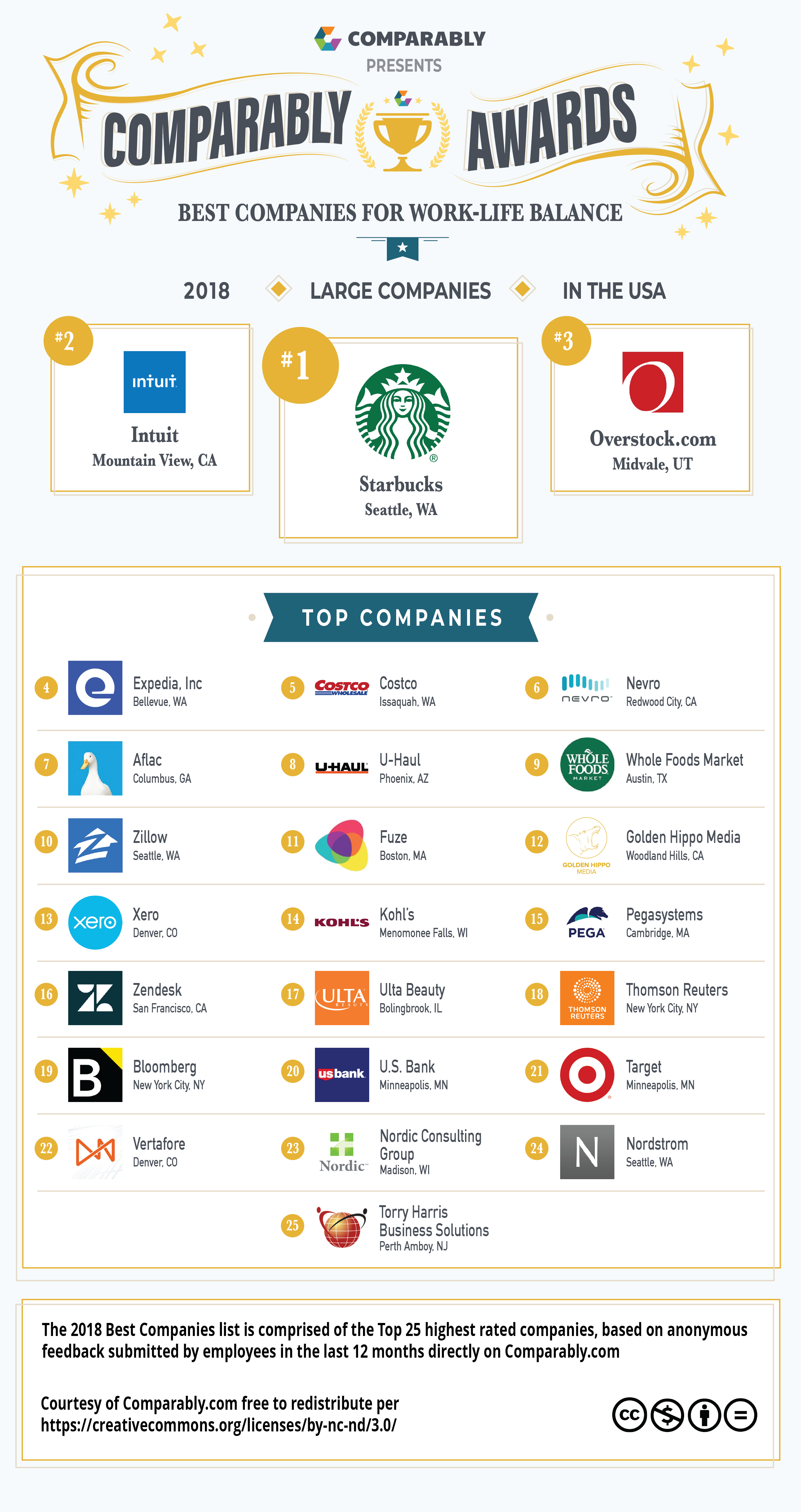New research by US Compensation, Culture and Career Monitoring site Comparably.com shows some pretty dire results when it comes to employee satisfaction. An anonymous survey was conducted to discover the Best Companies for Work-Life Balance, and asked employees a series of questions including “Are you satisfied with your work-life balance”, “How long do you take for lunch breaks” and “On average, how many hours do you work per day”. The key findings state that:
-
51% of people in design jobs and 49% of those in IT said they felt burnt out. These two industries represent the highest rates of burnout from those participating in the survey.
-
Only 34% of employees from the top 25 winning companies felt burnt out in comparison with 53% of employees from all other companies.
-
29% of people say their bosses expect them to work even on their annual leave
-
People ages 18-25 report the highest rates of working on their annual leave to keep up with the bosses’ expectations (37%)
-
People in Business Development are called upon the most during annual leave time.
-
33% say work-life balance is their number one concern over compensation, advancement and job stability.

What does Work/Life balance look like in Australia?
It is perceived that Australia is amongst the World’s best countries for a balanced approach to work, but the most recent Australian Work and Life Index (or AWALI) Report performed by the University of South Australia claims that Work-life interference remains a persistent challenge in Australia despite some changes in childcare, parental leave and employment law in the past two decades, and that the length of working hours or time-strain, is the critical issue.
- Men are more likely to work long hours (48+) than women;
- However, regardless of whether working short or long part-time or full-time hours, women have higher work-life interference than men;
- For all employees, long hours (48+) are associated with high work-life interference;
- Working four or more hours longer than preferred is associated with as much work-life interference as working long hours;
- Just over one third of employees, men and women, prefer to work at least four hours fewer; this rises to three quarters of those working long hours;
- Men in part-time work are most likely to prefer more hours – over half would prefer to increase their hours by at least half a day (4 hours).
All of this demonstrates that we still have a way to go. But what actually defines work-life balance and how can we ensure that it is weaved into our company fabric?

How to achieve Work Life balance
The term first coined in the UK in the 70s, has come to be understood as the practise of finding a suitable balance between work and daily living. Areas of life other than work-life can be, but not limited to personal interests, family and social or leisure activities, and the most important factor in the perceived balance is shown to be the amount of time spent at work. One way of addressing this may be to reduce your company hours to 9am-2pm Monday to Friday. Simple! But…. Not very effective as this is obviously going to affect productivity. An alternative proven to work well is by introducing flexible working hours and a working from home culture that is supported and exemplified from the top down. This shows employees that they are being treated as adults, entrusted to work their agreed hours at times that will suit them. This approach has the added benefit of getting the very best work out of those who find their most productive hours are not necessarily within the “normal” 9-5 structure, and instead need extra time within those hours to rest and restore brain power. Ultimately, and I speak from experience, if someone is in the right job – they will be enjoying most of the work they’re doing and if the company values align, engaging in it won’t even particularly feel like “work”. Being given the autonomy to work how and when we choose will allow workers to learn to appreciate the value of the time they spend on work and balance it with the time spent on life’s other priorities.
A more appropriate way of thinking about work-life balance therefore, may be as a 'rhythm'
Worklife Rhythm
The New York Times Bestselling Author and professor behind the TED original podcast “WorkLife” tweeted recently that the term ‘balance’ sets an unrealistic expectation of keeping different roles in steady equilibrium. Instead, we should “Strive for work-life rhythm. Each week has a repeating pattern of beats – job, family, friends, health, hobbies – that vary in accent and duration.” To continue this metaphor, managers who understand that each ‘beat’ of an employees’ life can enhance and enrich the overall sound, are more likely to entrench this philosophy into their business. Introducing policies that support this will help to mitigate the estimated $125 billion to $190 billion loss to businesses per year for burnt out employees in health costs and other associated costs such as talent acquisition, engagement and productivity. However, “whether framed as unintended consequences or overt discrimination, it is crucial to recognise that work-life policies will only be effective to the extent that workers do not experience economic, social or career penalties with their use”, the AWALI Report cautions.
Hiring a temp worker can help you achieve work-life balance by allowing you to focus on what really matters, and get more from your day to day.


In honour of International Women’s Day, we celebrate for women’s rights and equality around the world, everyday at Weploy. We’ve seen such an amazing accomplishment in the world, especially in recent years. In 2020 and 2021, countries with women leaders, (such as New Zealand, Germany and Bangladesh) received global recognition for their efforts during the COVID-19 pandemic; Kamala Harris became the first female, Black and South Asian American Vice President of the United States; and Scotland became the first country to allow free and universal access menstrual products.

What was your first job?

My Background
I’m Mei Chin Ee, I’m from Malaysia. I was working at a Training Consultancy back home for 16 years. Over the years there, I helped to develop the financial processes and by the end, I was actually managing the whole department. We were responsible for the delivery of profit and loss reports for Senior Directors in balance sheets on a dashboard. But we were getting consistent feedback that it was difficult to visualise, so I played around with the data and templated some new graphical reports - so that the Directors could develop insights more easily and visually see how far we were from the strategic goals.
Streamline your hiring
Business support staff with no hidden fees. Start hiring anytime.
